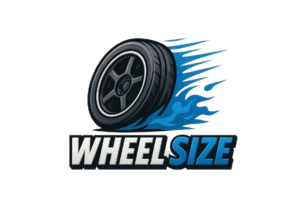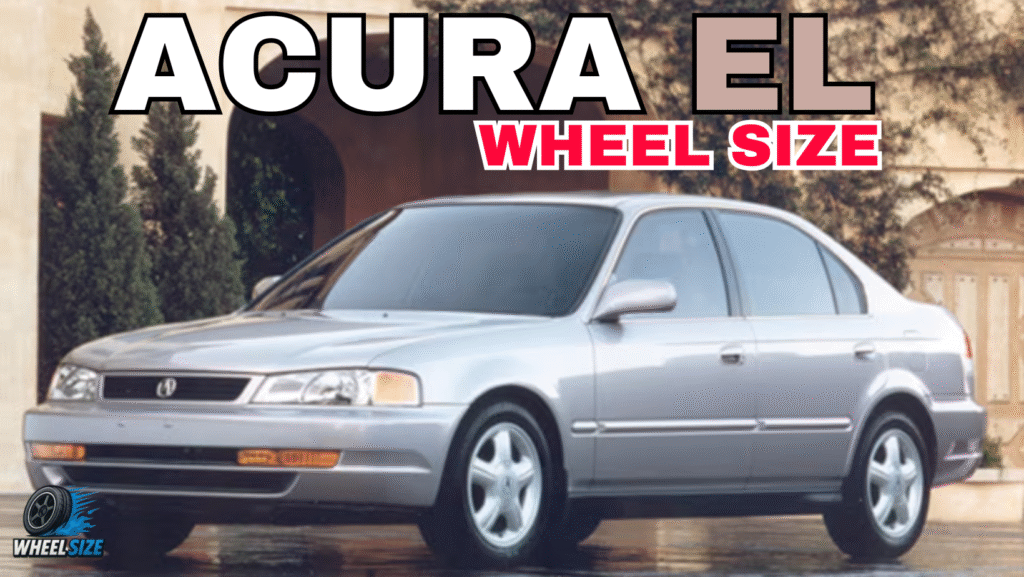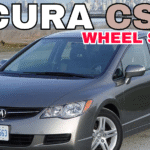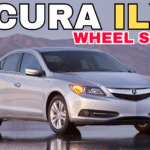The Acura EL was Honda’s smart blend of elegance and usefulness that was only available in Canada. Built around the dependable Honda Civic architecture, the EL delivered an upmarket driving experience in a tiny package. Getting the appropriate wheel fitting is important whether you’re keeping your wheels stock or upgrading them for look or performance. If you don’t set things up right, you could end up with uneven tire wear, bad handling, or problems with clearance. For all generations of the Acura EL (1997–2000 and 2001–2005), this guide tells you everything you need to know about the wheel specs, such as the bolt pattern and tire sizes. We’ll also talk about some crucial things to keep in mind when buying aftermarket wheels and how to avoid typical fitment problems. You’re in the ideal location if you want to know what the right bolt pattern, hub bore, or how to fit a set of clean 17s without rubbing.
Acura EL Wheel Fitment Overview
The Acura EL makes it rather easy to fit wheels. Both models have the same 4×100 bolt pattern, which is a common size that gives you a lot of choices when it comes to aftermarket wheels. The normal hub bore is 56.1mm, so if your wheels have a different bore, you’ll need hub-centric rings to make them fit snugly. The EL came with either 14- or 15-inch rims, depending on the year and trim level. Offsets are usually +45mm, which keeps the fenders and suspension parts from being too close to each other.
The OEM wheel sizes work well with the car’s suspension tune and give a decent blend of comfort and control while driving. But there is still room to play. If you choose the right offset and tire profile, you should be able to accommodate wheels up to 17 inches in size without any problems. To avoid rubbing or steering problems, it’s preferable to stay within a width range of 6 to 7.5 inches. If you want to improve the look or grip of your car, the first step is to comprehend these specs.
Read About: Acura CSX Wheel Fitment
1st Generation Acura EL (1997–2000) Wheel Specs
Bolt Pattern & Lug Nut Info
The 1st-gen Acura EL from 1997 to 2000 has a 4×100 bolt pattern, which was standard for small cars at the time. It signifies that there are four bolts arranged in a circle with a distance of 100mm between them. The thread size of the lug nuts is M12x1.5. To make sure they fit securely, you need to use the right type of seat, which is usually conical or acorn. If you over-tighten or use the wrong lug nuts, your rotors may distort or your wheels may shake.
The lug nuts should be tightened to about 80 ft-lbs, which keeps everything tight without making it too tight. Check to see if the new wheels use the same type of seats before you put them on. This is especially important if you are replacing wheels or getting new ones from a third party. The hub bore for this generation is 56.1mm. If your new wheels have a bigger bore, don’t forget to get the hub-centric rings. They assist keep everything in line and stop irritating vibrations at higher speeds.
OEM Rim Size & Offset
The factory rim diameters for this generation are usually between 14×5.5 inches and 15×6 inches. These sizes were a good combination for everyday driving because they gave you enough padding to be comfortable without making the car harder to drive. The usual offset is +45mm, indicating the mounting surface is 45 millimeters toward the outside of the wheel centerline. This offset makes sure that the wheels sit flat and don’t stick out too much or tuck in too much.
Picking an aftermarket rim? In general, staying in the +38mm to +48mm offset range is safe and will keep your suspension and fenders from hitting anything. For a sportier look, the rim width can optionally go up to 7″. Just make sure that your overall diameter doesn’t differ too much from stock so that your speedometer works right and you don’t scrape against anything when you turn.
Recommended Tire Sizes
The 14-inch wheels come with 185/65R14 tires, and the 15-inch wheels usually come with 195/55R15 tires. These sizes are a good mix of comfort, grip, and fuel economy. If you want to make your car bigger, you can install 16-inch wheels with 205/45R16 tires or 17-inch wheels with 205/40R17 tires without making any big changes.
When you upgrade, the width and profile of your tires are important. A wider tire delivers more grip but may lead to rubbing if you go too wide without modifying offset or fender clearance. For a 1st-gen EL, it’s advisable to choose tires that are less than 215 wide so they fit without any problems. And keep in mind that low-profile tires may look nice, but they can make driving on bumpy roads less comfortable.
2nd Generation Acura EL (2001–2005) Wheel Specs
Bolt Pattern & Lug Nut Info
The 2001–2005 Acura EL has the same 4×100 bolt pattern and M12x1.5 lug nuts as the original generation. Even while the layout keeps the same, it’s still very important to make sure the wheels are properly torqued. Keep them at about 80 ft-lbs and check them again after driving a few kilometers to make sure nothing has come free.
The hub bore stays at 56.1mm, therefore any aftermarket wheels with a bigger bore will need hub-centric rings. These minor modifications make a tremendous impact in how your wheels feel at highway speeds. You can feel vibrations or see uneven tire wear if you don’t do them. Also, make sure that the lug nut seat type matches the design of the new wheel. This will make sure that it fits tightly and safely.
OEM Rim Size & Offset
Most grades of the second-generation EL came with 15×6-inch alloy wheels as standard. The offset stayed at +45mm, which is good for the EL’s suspension geometry. This keeps the wheels from sticking out too much or sitting too far in, which can cause problems like tires wearing out too quickly or the suspension touching.
Wheels that are 16×6.5 or 17×7 inches wide work nicely if you want to change things up, as long as the offset stays between +38mm and +48mm. A higher offset moves the wheel closer to the fender, while a lower one moves it away from the fender. Just make sure that the wheels you choose don’t get in the way of your brakes or the inner wheel wells, especially when you turn.
Recommended Tire Sizes
The size of the tires that came with the 2001–2005 Acura EL is 195/60R15. This setup gives you a pleasant ride and good traction. If you’re upgrading up to 16-inch wheels, 205/50R16 is a terrific match. 205/45R17 fits well for 17-inch improvements and doesn’t change the speedometer or ride quality too much.
If you don’t change the suspension or fenders, you shouldn’t go over 17 inches. Remember that the width of the tires is very important for fitment. If you don’t change the offsets, tires wider than 215 can rub. When buying performance tires, you should also carefully verify the load and speed specifications. They should match or exceed your stock setup.
Aftermarket Wheel Fitment Tips for Acura EL
Changing the wheels on your Acura EL is a fun way to make it your own, but you need to be careful with the technical details. Start with bolt pattern—4×100 is your basis. Next, pay attention to the offset and width of the wheels. The safest width range is 6 to 7.5 inches, and offsets should be between +38mm and +48mm. This prevents tires from rubbing against fenders or struts, especially during sharp bends or full suspension compression.
If you want your wheels to fit flush without spacers, they should have a +40mm offset. This provides you a sportier posture while keeping the clearance safe. When you buy wheels, make sure the hub bore is 56.1 mm. If not, use hub-centric rings to keep things in the right place. Lastly, think about the size of the tires and the height of the sidewalls. Lower profiles seem sleek, but they make the ride stiffer. 205/50R16 or 205/45R17 are suitable sizes for everyday driving. If you set up your EL correctly, it can look nicer and handle better without losing comfort.
Common Wheel Fitment Mistakes to Avoid
When Acura EL owners upgrade their wheels, one of the most common mistakes they make is not paying attention to the offset. Choosing a wheel with an offset that’s too low can push the wheel out over the fender line, generating friction or a stretched look. On the other hand, an offset that is excessively high might make the wheels tuck in uncomfortably and mess with the suspension.
Another error is ignoring the size of the hub bore. If you put on aftermarket wheels with a bigger bore and don’t utilize hub-centric rings, you can feel vibrations at higher speeds. A lot of people also don’t think about how important it is to use the right lug nuts. If the seating type doesn’t fit the wheel design, the wheels could come free or the studs could break.
Lastly, a huge mistake is not knowing the right size of tires. Rubbing is common when tires are too big and the offset or fender clearance isn’t changed to match. Stay within the recommended range and don’t only go for looks; think about how well the fit works too.
Conclusion
It’s not rocket science to get the correct wheel arrangement for your Acura EL, but you do need to pay attention to the little things. Both generations share a lot in common when it comes to bolt pattern, hub bore, and offset, making upgrading quite straightforward. Whether you’re restoring your EL or giving it a fresh new look, understanding wheel fitment helps you make informed decisions. Always check that your tires have enough space before you hit the road. Stick to the safe offset range and use the right lug nuts. A set of wheels that fits well not only makes the automobile seem better, but it also makes the ride smoother and safer.
FAQs
Q1. Can I install 16” wheels on my Acura EL?
Yes, 16” wheels with 205/50R16 tires fit perfectly without modifications.
Q2. What’s the largest tire size I can run without rubbing?
Generally, 205/45R17 is the upper limit without suspension or fender mods.
Q3. Are Acura EL and Honda Civic wheels interchangeable?
Yes, both share the same 4×100 bolt pattern and hub bore size.
Q4. What offset should I choose for flush fitment?
+40mm on 7″ wide wheels provides a clean, flush look.
Q5. Do I need hub-centric rings for aftermarket wheels?
Only if the wheel’s center bore is larger than 56.1mm—they help avoid vibrations.



